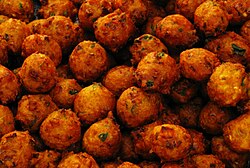This article needs additional citations for verification .(February 2013) |
 | |
| Alternative names | Aloo chop/Aloo Bonda |
|---|---|
| Place of origin | South India |
| Region or state | Odisha, Andhra Pradesh, Karnataka, Kerala, Tamil Nadu, Telangana, Maharashtra |
| Serving temperature | Hot |
| Main ingredients | Gram flour batter, potato (or other vegetables) |
Bonda is a deep-fried South Indian potato snack [1] [2] that has various sweet and savory versions in different regions. The most common is aloo bonda (potato bonda), and other region-specific variations include potato replaced with sweet potato, tapioca, grated pineapple, green peas, paneer, or other ingredients including rice.

